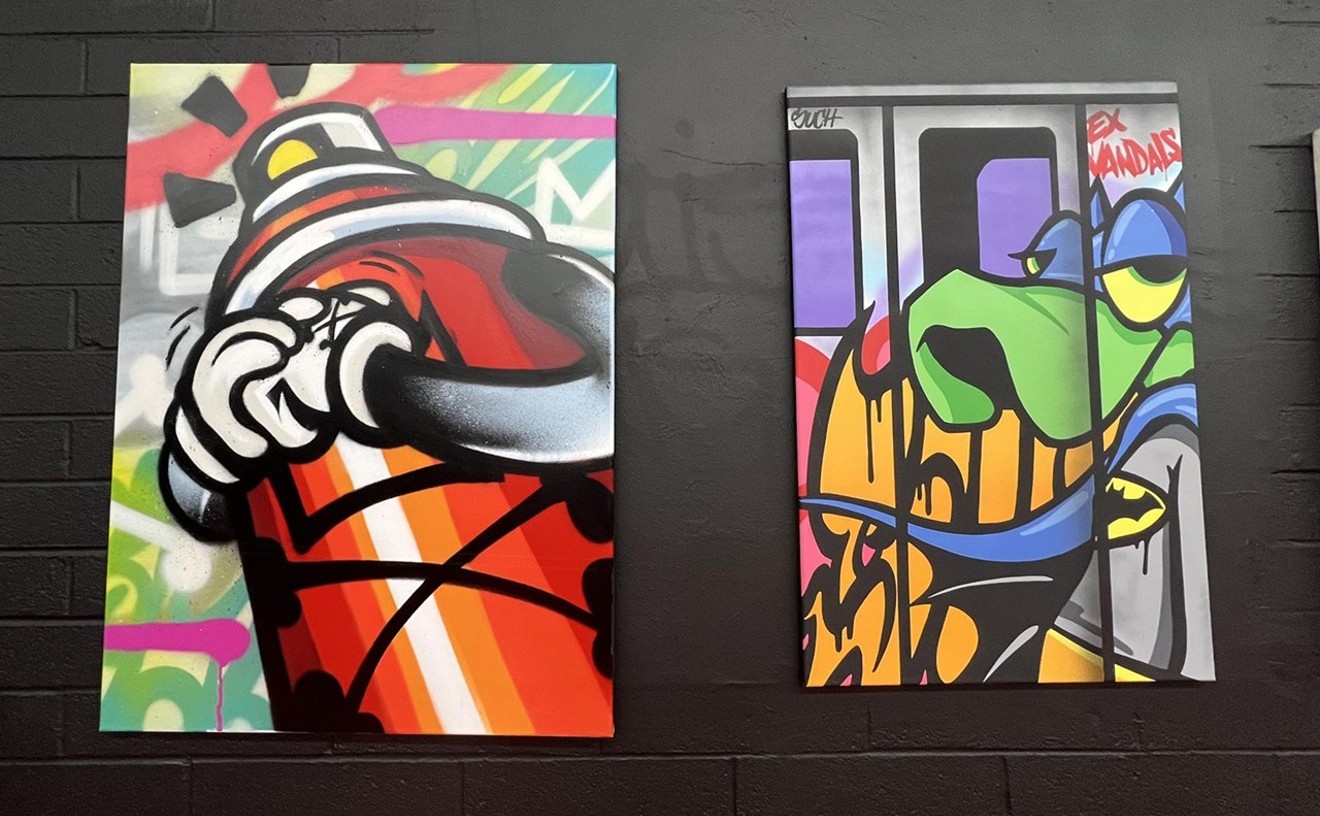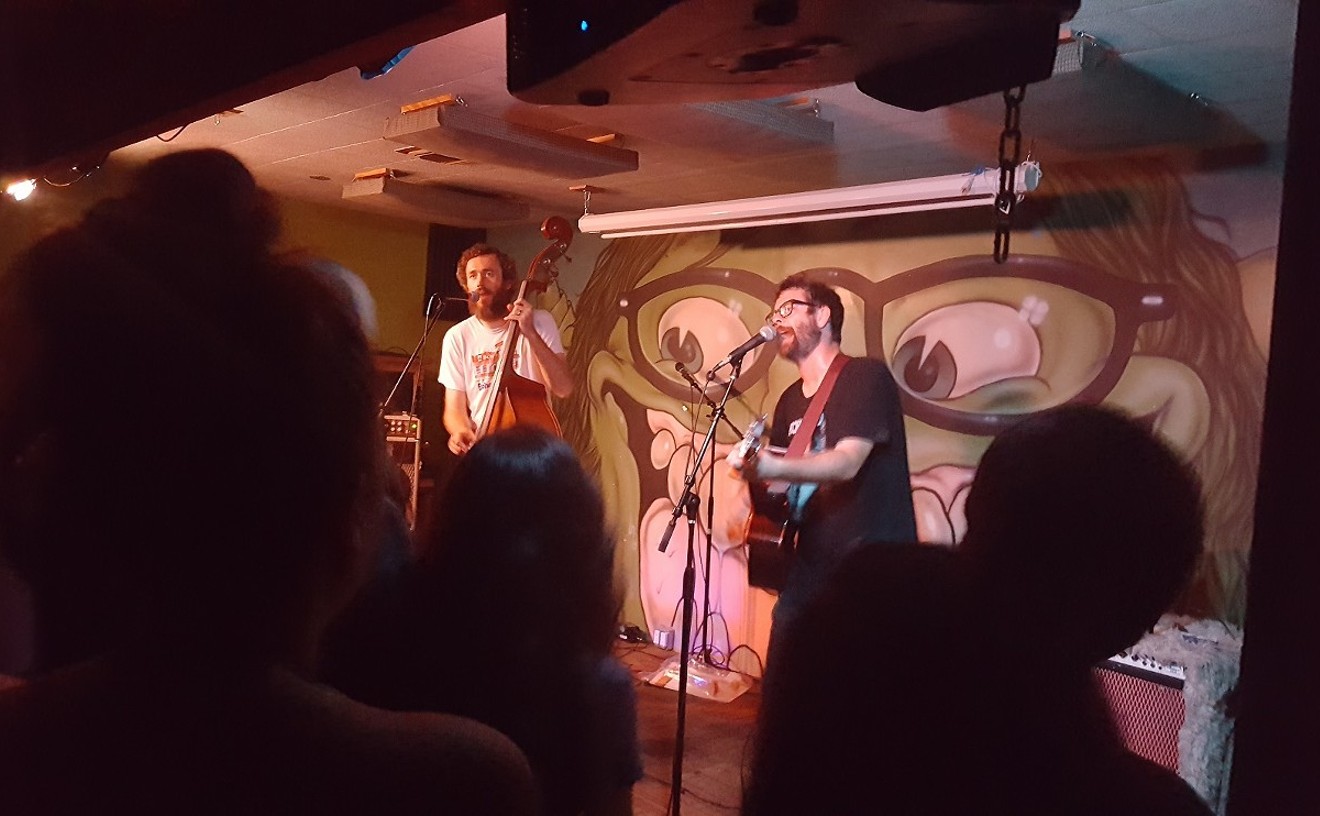A refugee from the severe economic downturn wracking my beloved native Southern California, I had rolled into Phoenix in late '92, kicking and sobbing. That particular day, it was 105 degrees and two of the three money-sucking air conditioners in our rental house were down. No one, except for government types, had an Internet connection, cell phones were the size of small suitcases, and satellite radio was not an option to avoid Rush Limbaugh harangues as you drove across the desert. Resorts, retirees, and right-wing conservatism seemed to reign supreme here, with not a Vietnamese restaurant in sight. I thought I was going to die.
Then I saw those pots.
I had stumbled onto an eye-catching series of screwy-scaled vessels made from a combo of painted concrete and steel, officially titled Wall Cycle to Ocotillo. The pots, I would later learn, were the cornerstone of a half-million-dollar sculpture/landscaping public art project awarded by the fledging Phoenix Arts Commission to two Massachusetts artists, Mags Harries and Lajos Heder. A number of them perched and teetered atop freeway sound barriers running north from McDowell Road to Ocotillo Road, just south of Glendale Avenue.
They mesmerized me. Those pots gave me a flicker of hope that Phoenix wasn't as culturally desiccated as I'd thought — that someone here in this vale of triple-digit temperatures and double-digit I.Q.'s actually had a pretty artfully honed sense of humor. Not-so-fond memories of the rabid criticism they sparked haunted me recently when a similar crisis erupted over a spectacular sculpture proposed for a new downtown park.
Little did I know that my miraculous pots were at the center of a local political firestorm that ratcheted Phoenix's public-opinion heat index considerably above tolerable. Commonly referred to as The Squaw Peak Pots, the public art project was envisioned as a way to mitigate the ugliness of freeway noise-abatement walls that sliced through a number of neighborhoods when the 51 was expanded. It also included sculptures in sitting areas, gardens, and canal rest stops on the neighborhood side of the walls.
Enraged by the freeway's literal incursion into their backyards and feeling left out of the process of choosing art for the affected areas, many residents became even more fired up about both the pots' presence and their allegedly unconscionable cost at a time when Phoenix was in the throes of the bust portion of the Valley's traditional boom-or-bust market cycle. However, the rest of the world (including Newsweek and the New York Times) was soon applauding Phoenix's public arts program as a visionary template for the melding of art and infrastructure, one that ultimately would garner awards and admirers the world over.
I largely blame the mainstream local media for the public ire. The woefully uninformed Arizona Republic columnist E.J. Montini led the brigade of malcontents infuriated by the pots. Then, talk radio jumped into the fray, raising any possible dialogue to diatribe. When an unidentified jokester placed a golden commode and a beat-up garbage can atop of one the walls, followed by someone toppling a large glass sculpture by lassoing it, Wild West-style, TV coverage began in earnest. City officials looking for a photo op, specifically Mayor Paul Johnson and city councilman (and future mayor) Skip Rimsza, became part of the feeding frenzy. The City Manager's Office, as well as the mayor and council, did much chest-beating over their perceived lack of supervision and control over the Arts Commission and the selection process for public art.
Also stoking the conflagration were cranky artists from Phoenix's still- nascent arts community. According to Beatrice Moore, undisputed doyenne of the downtown arts scene and a member of the Arts Commission at the time, these artists had their noses out of joint because the project had been awarded to out-of-state artists.
Ultimately, after several years, the 51 was expanded again and six pots visible from the freeway were taken down. One of those had been vandalized beyond repair. The rest remain in storage to this day because it would require costly re-engineering of the renovated freeway sound walls to accommodate the heavy pots.
Most of the great pieces on the neighborhood side still exist, however, with nary a whimper from residents. I'm still mourning the disappearance of those freeway pots into stored oblivion. They were a crucial part of Phoenix's early public art history.
What a difference 15 years can make. With Phoenix's burgeoning physical growth came serious cultural development. Phoenix Art Museum was expanded, and new Valley museums and performance venues were built with bond money. Museums, especially Arizona State University Art Museum, began gaining an international reputation for showing important contemporary art, and downtown galleries began to pop up like weeds after a good rain. First Friday art walks now bring thousands every month to a place that was once the sole realm of daytime office workers and questionable nighttime types.
And I went from solemnly swearing that I would not die and be buried in Arizona to fervently embracing its alien physical landscape and the ever-changing urban and cultural landscape that's developed here over time.
But some things never seem to change. Painful memories of the Squaw Peak Pots were resurrected for all public art supporters this past December. That's when the City Manager's Office unilaterally decided that Phoenix should not enter into a $2.4 million contract for the construction of a monumental wind-driven sculpture, designed by internationally renowned Boston artist Janet Echelman and inspired by the fleeting blossom of Arizona's singular saguaro.
Echelman's sculpture, which generally has been lauded in smart quarters as iconic and a critical part of downtown's revitalization, was specifically designed to anchor Civic Space Park, 2.7 acres just north of Van Buren between Central and First avenues, adjacent to ASU's new downtown campus, with the lion's share of its contract price going to Tucson-based Caid Industries Inc. for the piece's engineering, fabrication, and installation. It's to be crafted from UV-impervious, Teflon-coated thread netting that's been used for more than 40 years in very harsh conditions, according to Phoenix architect Will Bruder, who used the same stuff for the north-facing sails of the Burton Barr Central Library. The ethereal sculpture, 98 feet in diameter, will be suspended almost 60 feet above ground, its magical shape-shifting quality provided by the wind, with subtly changing colored uplights illuminating it at night. The piece's elevated design maximizes the park's space for visitors and would serve as the perfect symbol identifying Phoenix to the outside world as an eternally changing metropolis, both physically and culturally.
The city manager's puzzling recommendation was made despite the city having already paid a substantial design fee to Echelman, not to mention the untold hours invested in the project's development by city staff, contractors, private citizens, and the artist herself.
The reason for dumping the Echelman project? It supposedly would cause at least a three-month delay of the November 2008 opening of the park, which was scheduled to happen simultaneously with the launch of the light rail and other new downtown developments. However, a side-by-side review of proposed park construction schedules — both with and without the art — drafted by park contractor Foresite Design & Construction, Inc. and freely available to the City Manager's Office, reveals that the delay involved was actually projected to be a grand total of two weeks, not three months.
Let's keep it real, folks. This was a purely political move in tanking economic times designed by City Manager Frank Fairbanks and deputy manager Ed Zuercher to blatantly circumvent the bureaucratic steps put in place years ago to ensure fairness in the public arts selection process.
"I spent a year of my life crafting what was eventually called a 'memorandum of understanding,'" says Lewis and Roca attorney Richard Goldsmith, a member of the Phoenix Arts Commission from 1998 to 2004 and chair of the Art in Public Places Committee during the height of the pots debacle. That memorandum of understanding was a carefully drafted compromise hammered out between the Arts Commission, whose very existence was on the line because of the pots, and city staff, including the mayor, city council and city manager's office, regarding the public process, procedures and guidelines for public art selection and execution. It also provided for extensive community input and participation.
Funny that the proposed contract-nixing also just happened to occur after the sculpture was shrilly criticized by a chorus of disgruntled citizens squeezed by yet another economic slowdown, most of whom never participated in the selection process. These armchair cowboy critics — people who apparently can't get past kitschy kokopellis, howling coyotes, and cutesy cacti — predictably screamed about the sculpture being "too arty" and City Hall squandering unspeakable sums on a piece of sculpture when Phoenix was in the throes of a serious budgetary shortfall caused by a nose-diving housing market and flaccid sales tax revenues.
People still don't grasp that Phoenix's public art is paid for by Percent for Art money, and not out of the city's general fund. I asked, and it turns out that one penny of every dollar the city spends on public construction (with the exception of land purchases and the cost of any equipment for essential city services, such as computers, cars, fire trucks, police cars and sanitation trucks) gets put in this fund and cannot be used for anything other than art.
Armed with facts, ferocity, cell phones, and one hell of an e-mail list, the local arts community, supported by downtown business-development coalitions, and citizen support groups, rallied the troops and elegantly took down the opposition at council meetings and in print. To their credit, Mayor Phil Gordon and most of the City Council had the huevos rancheros to go forward with the Echelman contract, in spite of naysayers who variously described the Echelman sculpture as looking like an upside-down cowpie, a floating jellyfish, or an empty thought bubble.
So what's made the difference between the general reaction to the infamous pots and to Echelman's proposed sculptural piece?
Most people opine that the change is due to Phoenix's significant urbanization in the past few years. And with it has come a certain urbanity as well. There's been an influx of people from large urban centers like L.A., New York, and Chicago, as well as growing Hispanic, Indian, Pakistani, African, Chinese and Southeast Asian populations, all of which have resulted in cultural and political diversity. We no longer see second-residence citizens fleeing from the summer heat and donating funds and art only to their original hometown cultural institutions. Business is also on board, having realized that not everyone in the universe is a sports fan and that unique public art can bring in big tourist bucks and resuscitate moribund downtown areas, as Chicago's Millennium Park has done.
Even more important has been the flowering of arts advocacy groups — Phoenix Artlink, Voices Downtown Coalition, and Arizona Action for the Arts, in particular — and the maturation of the Phoenix arts community, which has learned how to organize, petition, lobby, and push the political process to its advantage and for whom there are more public art commission opportunities. Most important, a political process exists through which the mayor, City Council, city manager, and citizenry have active roles in choosing what they want to see in their city.
One thing hasn't changed. E.J. Montini is still stirring the pot (or, in this case, mucking with the net), though I consider his opinion on public art projects about as informed and insightful as supermodel Naomi Campbell's recent interview of Venezuelan President Hugo Chavez. In a recent column, attempting to kill the Echelman piece, he told his readers that "a large, difficult-to-understand sculpture is exactly what a piece of public art should be. But not in Phoenix. Not in Arizona."
Well, guess what, bubba? It's going to happen in Phoenix, Arizona. And you can stick that in your pot.










